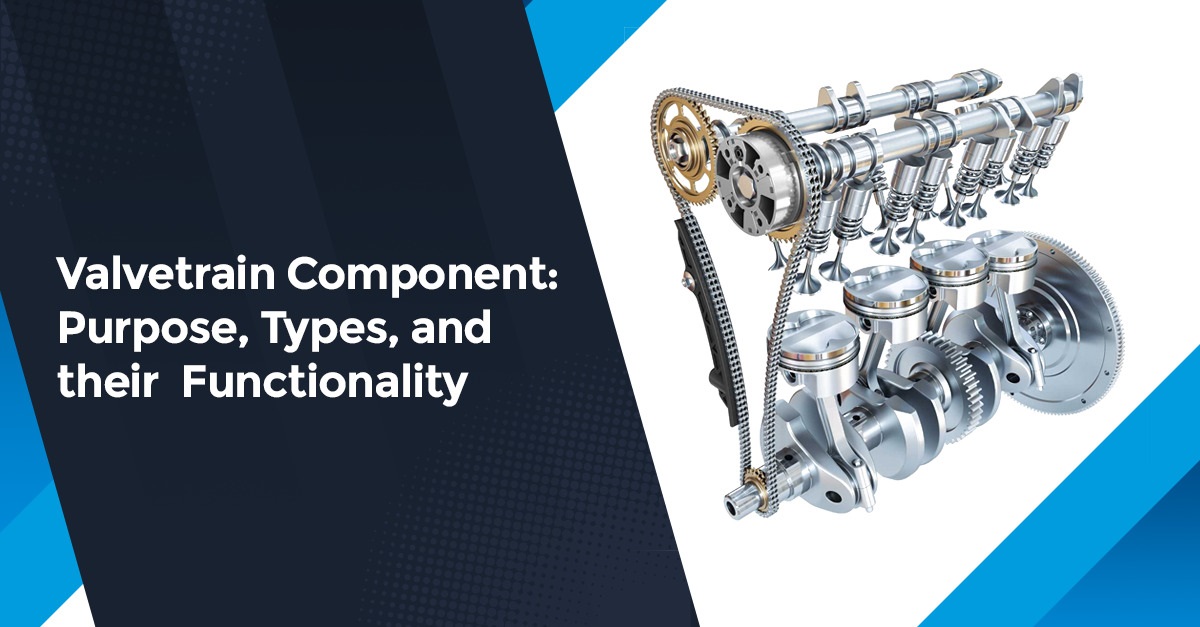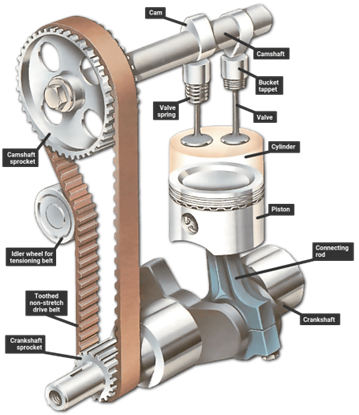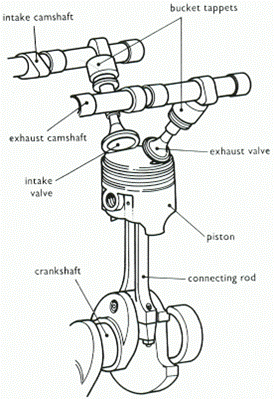

A valvetrain is a group of parts that make up the mechanical system that controls how to get air in and out of an internal combustion engine. It is one of the most critical parts of an engine as it acts like a mechanical computer for it. In order for an engine to function, the intake and exhaust valves need to open and close to the piston position at corresponding times. These valves are open and closed by a component called a camshaft. A camshaft is a shaft with oblong-shaped bumps called “lobes” welded-pressed or machined right into it. In other words, the components involved in the movement of the camshaft lobes to the valves are collectively known as the valvetrain. Valvetrain designs can vary in terms of how many valves there are, how many camshafts operate them, and where the components are located.

VALVE TRAIN COMPONENTS
The valve train can have many components. The following are the most common components used in valve train:
1. Camshaft: It’s the only shaft on which cams are installed. Its function is to control the timing and lift the profile of the valve opening. The crankshaft drives a camshaft and it rotates at half the speed of the crankshaft in the case of a four-stroke engine.
2. Camshaft Followers: A cam follower is a type of bearing that follows along the lobes of a camshaft as it rotates providing a low-resistant surface for the lobe to push up against. It's also known as a "lifter" or "tappet". There are several types of cam followers whose configurations depend on how they mount on their mating part. They are used when the cam is in the block rather than overhead.
3. Push Rods: It is a long, slender metal rod that is made up of carbon-manganese steel and is used in overhead valve engines. It transfers motion from the camshaft to the valves. At the bottom end of the pushrod is a lifter that comes into contact with the camshaft. As a result, the camshaft lobe moves the lifter upwards causing the pushrod to move as well. The rocker arm gets further pushed by the top end of the lifter, which opens the valve.
4. Rocker Arms: A rocker arm is an oscillating lever that conveys radial movement from the cam lobe into linear movement at the poppet valve to open it. Rocker arms transfer motion to the valves and are used in overhead valve engines, which are actuated by a pushrod and pivot on a shaft.
5. Rocker Shafts: These are shafts that rockers are on. It’s the pivot point for the rocker arms and conducts oil to the various rocker arms.
6. Valve Bridges: These are sometimes called valve yokes. They allow a single rocker to actuate multiple valves. It has a stem or bridge that sits on the valve stem so that when the rocker is pressed down, the valve stems get pressed down as well.
7. Valves: They consist of two primary sections – valve head and valve stem. The valve head allows the air to enter and exit the cylinder. The valve stem is pressed by a valve train and at its very end, there are grooves that keepers will fit to keep the valve in place. Valves open and close the inlet and exhaust passages of the cylinder.
8. Valve Springs: Valve spring is a key part of the valve train that keeps the valves closed tightly against their seats unless the cam opens the valve, which releases pressure. The cam will then continue through its motion releasing the valve and allowing the valve spring to do its job, and retracting the valve back into the head.

Timing valves correctly is a delicate tightrope walk between smoothness, efficiency, and power. Even a fraction of a millisecond could make a huge difference. The timing of the valvetrain can be adjusted for either an optimum balance of power and efficiency or even to take the efficiency level to the maximum.
The valve train ensures the opening and closing of the cylinder valves which are kept in synchronization and are necessary for any combustion engine. A lot of new and advanced ways of valve maintenance have been thought about such as building a hydraulically actuated pneumatically controlled valve set and independently controlling it or employing the use of AI (artificial intelligence) to predict and decide the function of the valve has been taken into consideration. In fact, recent investments are being made into digital valve positioners, controllers, and full systems to monitor valve performance online anytime.
Ghaziabad Precision Products (GPP) is a world-class valve train manufacturing company that offers smart technology and comprehensive solutions for valve train components, casting products, chassis components, and engineering springs. GPP is equipped with the latest advanced machinery and auto equipment in hot forging, projection welding, spring end grinding, precision machining, hardening & tempering, shot peening, and so much more. It believes in delivering the best quality at the lowest competitive cost and strives for excellence whiledelighting its customers in whatever it does.